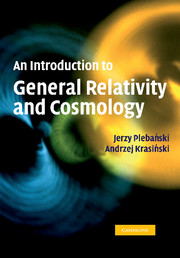Book contents
- Frontmatter
- Contents
- List of figures
- The scope of this text
- Acknowledgements
- 1 How the theory of relativity came into being (a brief historical sketch)
- Part I Elements of differential geometry
- Part II The theory of gravitation
- 12 The Einstein equations and the sources of a gravitational field
- 13 The Maxwell and Einstein–Maxwell equations and the Kaluza–Klein theory
- 14 Spherically symmetric gravitational fields of isolated objects
- 15 Relativistic hydrodynamics and thermodynamics
- 16 Relativistic cosmology I: general geometry
- 17 Relativistic cosmology II: the Robertson–Walker geometry
- 18 Relativistic cosmology III: the Lemaître–Tolman geometry
- 19 Relativistic cosmology IV: generalisations of L–T and related geometries
- 20 The Kerr solution
- 21 Subjects omitted from this book
- References
- Index
21 - Subjects omitted from this book
Published online by Cambridge University Press: 01 March 2010
- Frontmatter
- Contents
- List of figures
- The scope of this text
- Acknowledgements
- 1 How the theory of relativity came into being (a brief historical sketch)
- Part I Elements of differential geometry
- Part II The theory of gravitation
- 12 The Einstein equations and the sources of a gravitational field
- 13 The Maxwell and Einstein–Maxwell equations and the Kaluza–Klein theory
- 14 Spherically symmetric gravitational fields of isolated objects
- 15 Relativistic hydrodynamics and thermodynamics
- 16 Relativistic cosmology I: general geometry
- 17 Relativistic cosmology II: the Robertson–Walker geometry
- 18 Relativistic cosmology III: the Lemaître–Tolman geometry
- 19 Relativistic cosmology IV: generalisations of L–T and related geometries
- 20 The Kerr solution
- 21 Subjects omitted from this book
- References
- Index
Summary
As stated in the introduction, it would not be possible to include the whole of relativity in a book of manageable size. We chose to go into several selected topics in depth, but omitted some other topics completely or nearly so. This short chapter is a list of the topics we omitted, with some suggestions to the reader for further reading.
The following topics were covered inadequately or not at all:
1. Gravitational waves. Speaking most generally, a gravitational wave is any gravitational field that propagates through space independently of matter. It may, but need not, be periodic. There exists a large collection of exact solutions of Einstein's equations describing waves, for these see Stephani et al. (2003). There exists also an elaborate theory of nearly-linear waves, a relatively good source for it is the book by Ohanian and Ruffini (1994), and also the classic MTW course (Misner, Thorne and Wheeler, 1973). The theory of generation and detection of gravitational waves is worked out rather well, but progress in it is still going on, so current knowledge can be gained only from papers. A sophisticated and elaborate experimental technology is already in place, but to keep up with this one has to attend conferences in addition to reading the literature. The pioneer of the search for gravitational waves was Weber (1961); his small book can be recommended to readers interested in the history of the subject.
2. The Cauchy problem. In each coordinate system, the set of Einstein's equations can be separated into those equations that contain at most the first-order time derivatives of the metric components and those that are of second order in time.
- Type
- Chapter
- Information
- An Introduction to General Relativity and Cosmology , pp. 498 - 500Publisher: Cambridge University PressPrint publication year: 2006



